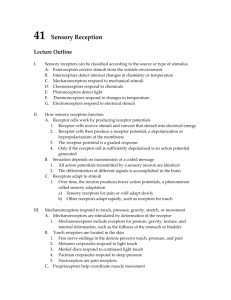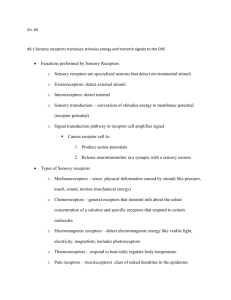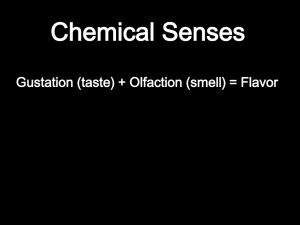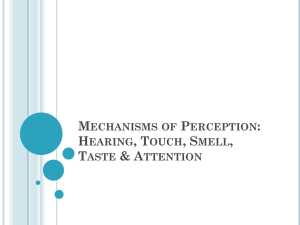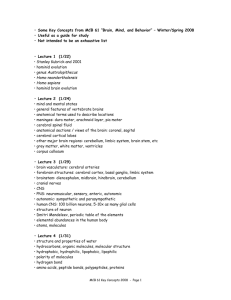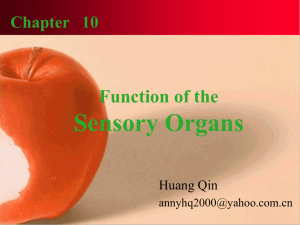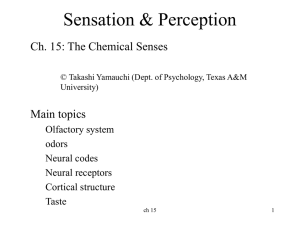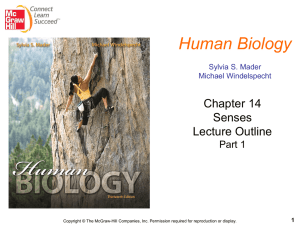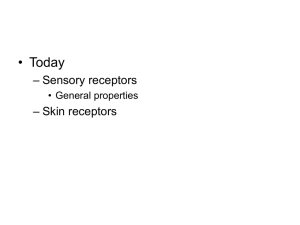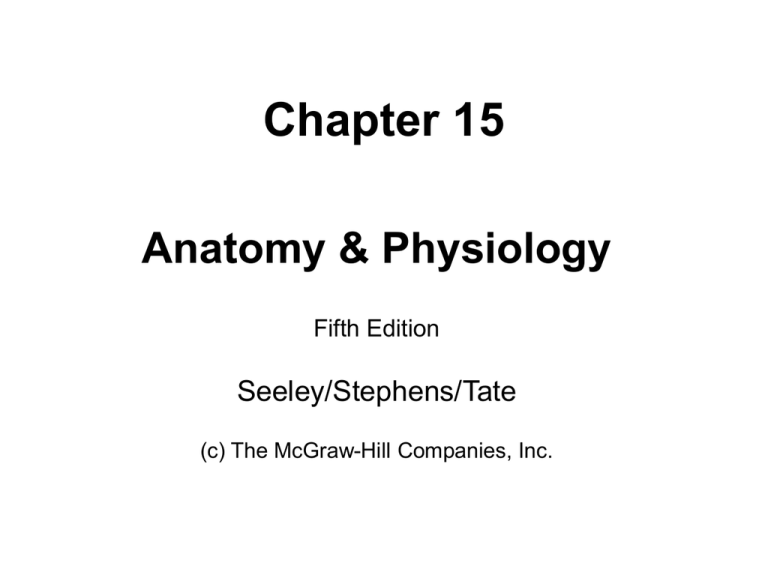
Chapter 15
Anatomy & Physiology
Fifth Edition
Seeley/Stephens/Tate
(c) The McGraw-Hill Companies, Inc.
The Senses
• Information gathered by the sensory receptors go up the afferent
neurons and are processed at the cerebral cortex.
• Sensory receptors work in response to the stimulation from the
environment as well as the change observed within the body, where
regulation by negative feed back is needed.
• Each specific sensory receptor is designed to pick up
corresponding stimuli, such as heat, pressure, light, sound, et… and
transmit to the primary sensory cortex of its own.
• However, if the stimulus is applied to the receptor other than the
form of its primary function, the receptor may still respond and
give a signal to the sensory cortex. You will see a flash of light
when your eye is hit.
• Furthermore, if the input is given to a simple nerve
ending, the neuron may pick up any stimuli without
discrimination.
• The sensory receptors are known to adapt to the level of
input. Adopting to hot bath, noise, taste, smell, etc…
• On the contrary, the sensitivity of sensory receptors
may be increased by the command from the higher
order. For example, if you are commanded to listen
carefully you do indeed listen carefully.
• Classification – the senses may be divided into 3
major types, which use 5 different types of receptors.
(Table 15.1)
• Three types of senses are:
– Somatic sense – response of the body to the
environment, such as touch, pressure, temperature,
proprioception and pain.
– Visceral sense – sensation within the body, such as
pain pressure.
– Special sense – sensation felt by specialized organs,
such as smell, taste, sight, sound and balance.
• In order to detect these stimuli, at least 5 receptors
have been identified.
– Mechanoreceptors
– Chemoreceptors
– Photoreceptors
– Thermoreceptors
– Nociceptors
• As has been mentioned, these receptors may respond
to other stimuli than originally identified.
Sensation
• A stimulus may excite a receptor and generate an action
potential.
• But to be recognized as stimulation, the action potential
must travel through afferent neurons to the cerebral
cortex to be sensed as a stimulus.
• The action potential may travel to the parts of the brain
such as the cerebellum and remain as unconscious
information.
• Adaptation or accommodation to stimuli may be
processed by CNS.
• Another modification to stimuli may be found in
proprioceptors. There are two types of proprioceptors:
tonic and phasic.
– Tonic receptors generate action potentials as long as
stimuli are applied and accommodate (adapt) slowly,
locate position of your body parts.
– Phasic receptors accommodate rapidly and sense
only when there is a change – moving body parts.
• Types of Afferent nerve Endings – somatic and visceral
sensation may arise from at least 8 types of sensory nerve endings
(Table 15.2 and Fig. 15.1)
– Free nerve endings – distributed throughout all parts of the
body and responsible for a number of sensations , such pain,
temperature, itch and movement.
– Thermoreceptors – are essentially free nerve endings scattered
immediately beneath the skin, skeletal muscles, the liver, and
the hypothalamus.
– There are several times more cold receptors than hot receptors
and their structures are indistinguishable.
– The pathways of pain receptors and those of the
thermoreceptors are about the same, ii.e. the reticular
formation, the thalamus, the primary sensory cortex.
– Thermoreceptors are sensitive to the temperature change and
can quickly adapt.
• Pain receptors – pain receptors are found in the skin, joint
capsules, periosteal of bone, the walls of blood vessels.
• Found a little in deep tissues or visceral organs.
• Pains are transmitted with types of axons: fast pain with
myelinated axons and slow pain with non-mylinated axons.
• Fast pain ca be localized and respond quick somatic reflexes or
specific sensory cortexes.
• Slow pain, such as caused by burning, identifies only general area
of pain.
• Pain from visceral organs are often confused with the surface pain
coming from the same spinal nerves referred pain.
• Thus, the cause of upper chest or left arm pain may be from the
heart.
• The awareness of pain may be reduced by inhibition of pain center
in the thalamus, reticular formation, lower brain stem and spinal
cord.
• Merkel’s (or tactile) disks – flattened axonal ending associated
with epithelial cells.
• At the basal layers of the epidermis.
• Touch, pressure, and vibration.
• Fine touch and pressure receptors: for exact location, shape, size,
texture and movement.
• Hair follicle receptor – at the root of hair follicles and respond to
the motion of hair.
• Pacini’s or Laminated Corpuscles – single dendrite is found at
the center of this laminated receptor.
• Located in the dermis or hypodermis. (finger, breasts, external
genitalia.)
• Senses cutaneous pressure and vibration.
• The corpuscles associated with the joints help relay proprioceptive
information.
• Meissner’s or Tactile Corpuscles – in the dermal papillae.
• Two point discrimination touch.
• Different distribution densities leading to the different level of
position resolution.
• Ruffini’s End Organs – in the dermis of the skin of fingers.
• Respond to pressure and stretch.
• Golgi Tendon Organ – proprioceptive nerve ending at the tendon.
• Respond to stretch of the tendon.
• The afferent signal from the Golgi organ inhibits the motor neuron
of the associated muscle and makes it to relax. Thus, prevents
damage to the muscle by excessive contraction.
• Muscle Spindles – relatively short 3-10 muscles fibers
which are striated only on the ends of the fibers, ii.e
only the ends can contract.
• Sensory afferent neurons wrap around the non-striated
central region. Efferent gamma motor neurons attach the
striated ends.
• When the muscle is stretched, stimulates the muscle
spindle.
• The afferent neuron synapses with the alpha motor
neuron.
• Muscle contracts – stretch reflex.
Olfaction
• The structure of olfactory recess and bulb are shown in Fig. 15.3.
• Olfactory receptors are found in the olfactory epithelium of
olfactory organ together with the basal (these are stem cells) and
supporting cells.
• Exception to the rule that neuronal cells do not replicate, the basal
cells regenerate olfactory cells every two months.
• The olfactory cell’s dendrites ends are embedded in the mucus
layer excreted from olfactory glands and the axons extend into
olfactory bulbs, where the cranial nerve N I are found.
• The olfactory receptors are highly modified neurons and humans
have about 10-20 millions per 5cm², while a dog can have the
receptor surface more than 72 times of this.
• The average person can distinguish about 4,000 different odors.
Though it is not known how.
• Seven primary classes of odors have been proposed:
– Comphoraceous
– Musky
– Floral
– Peppermint
– Ethereal
– Pungent
– Putrid
• The olfactory receptor cells are highly sensitive and respond to the
dissolved chemicals in the mucus and change its permeability of
the membrane leading to a formation of an action potential.
• The information is often transmitted as the frequency of action
potentials.
• The axons from the olfactory bulbs directly reach the olfactory
cortex, but effector neurons reach hypothalamus and the limbic
system raising emotional behavioral responses. Smell good and
smell bad. (adaptation, effect of perfume)
Taste
• Gustatory (taste) receptors are located within the taste buds,
which are in turn protectively placed in the specialized papillae to
avoid mechanical stress. There are four types of papillae:
circumvallate, fungiform, foliate, and filiform which have no
taste buds.
• At the ending of gustatory cell, microvilli are found.
• The microvilli, responding to the chemical that causes
depolarization to initiate the action potential
• There are four primary taste: sweet, salt, sour, and bitter.
• Surprisingly, the chemical structures of artificial sweeteners are
not the same as sucrose.
• Peppery and burning sensation are with the general sensory
receptors.
• The afferent nerves synapses in the medulla, again in the
thalamus, and to the primary sensory cortex. Good taste
and bad taste.
• Perception of taste is extensively related to other senses.
• Integration with the olfactory receptor is especially
evident. For example, bad smell could ruin your
appetite.
Visual Physiology
• How subjects are recognized? Scattering, absorption
and reflection.
• Projection to retina.
• Visual recognition starts with recognition of light with
photoreceptors, rods and cones.
• In all the available instruments, human eyes are the
most capable of working under a very wide intensity of
light, ii.e. from the dim light under the moon to the
bright daylight in the beach. Minimum light intensity to
be recognized is about 40 photons.
• Our eyes are also sensitive to visible wave length of the
light ranging from red, orange, yellow, green, blue,
indigo and violet.
• Light (Fig. 15.16)
– Visible light and UV/IR
– color
• Light refraction and reflection
– Lens: focused imaged
– Reflection by the surface of an object
• Inner structure of an eye (fig.15.13)
• The Retina
• Rods and Cones – their names, rods and cones, come
from the appearance of their outer segments (15.18/19)
• Rods are very sensitive to the light. But do not distinguish colors.
They are found more at the outer edge in the retina. In the outer
segment of the rods there are light absorbing pigment called
rhodopsin.
• Cones are less sensitive to light, but they distinguish color. Because
there are at least three types of cones with specific colors of
iodopsins: red, green and blue cones, which will be decribed later.
• Cones are concentrated near the opposite end of the lens, fovea, at
a higher density to provide high resolution.
• Failure for any these cones to develop ends in color blindness. The
most common color blindness is missing of the red cones, thus the
subject cannot distinguish red light from green light ( red-green
color blindness).
• Color blindness is caused by recessive sex linked genes.
• Photoreceptor Function – in the outer portion of each
•
•
•
•
•
photoreceptor, many layers of membranous discs are packed within
the membrane sack.
Photoreceptor pigments are located in these disks.
When the photoreceptor is at rest, gated sodium channels are open
in the outer segment causing depolarization at the synaptic end of
the cell.
Thus, in the dark, the neurotransmitters are continuously
released from the synaptic region of the photoreceptor leading to a
high frequency of spiked signals
Activated rhodopsin closes the Na+ gated channel and the cell
becomes hyperpolarized to stop sending the spiked signals.
When the receptor is stimulated with light, the Na+ channels are
closed and the rate of release of synaptic vesicles decreases, thus
the cell becomes hyperpolarized.
• Visual Pigments
•
a visual pigment, rhodopsin, consists of enzymes opsin and retinal
from Vitamin A.
• Retinal, with a slight modification, is the same for both rods and
cones.
• Three slightly different opsins bind with retinal to form three
iodopsins found in cones. Red, green and blue.
• Recognition of Light
• There are two forms of retinal: cis – (bent) and trans – (stretched)
forms.
• In the dark, the retinal takes the cis – form and the rhodopsin is
inactivated.
• This keeps open the gated Na+ channels of the outer segment of
the cell and keeps the cell depolarized.
• The cell continues to send spiked signals.
• When the cell is illuminated, the retinal becomes isomerized to the
trans-retinal and activated rhodopsin.
• activated rhodopsin closes the Na+ channels and the cell becomes
hyperpolarized to stop sending the spiked signals.
• These biochemical processes create an optical image on the retinal
surface and the image will be transmitted through the optic nerves
to the cerebral cortex.
• Shortly after the photo excitation, the trans-retinal will dissociate
from the rhodopsin (bleaching). The opsin will be recycled and the
trans-retinal will be put back to cis-retinal using the other enzymes
and ATP.
• Dark adaptation
• Fading image in the retina.
• Visual Pathway – recall the anatomy of retina
• There is a significant complexity of neuronal pathways
at the level of the retina.
• Eventually, the ganglionic cells extend their axons
together as optic nerves, cross over 50% of them at the
optic chiasm, and reach lateral geniculate nuclei at the
thalamus before finally arriving at large area of visual
cortex. (Fig. 15.22)
• Visual information is spread over the wide areas of the
cerebral cortex via lateral geniculate laterals from the
optic tracts.
• Visual inputs to the pineal gland establish a daily pattern
of activity, thus circadian rhythm.
• Equilibrium and hearing (review)
• Anatomy of the Ear – in the lab
• Auditory Function
• Sound is generated by vibrating matter such as drums,
tables etc…
• It travels through matter such as air, water,wood, metals
etc…, but does not travel through a vacuum.
• It has pitch and volume.
• Humans can hear within a certain range of pitch (20 –
20,000 cps) of louder than 0db, but less than 125 db
with pain.
• While other animals have different hearing ranges.
Example: a dog whistle can be heard by dogs, but not by
humans.
• Sound traveled through the air is:
• Collected by external ear and reaches tympanic
membrane (15.23)
• The vibration of tympanic membrane is transmitted to
auditory ossicles (three tiny bones) in the middle ear
consisting of malleus, incus and staples, while tensor
tympani and stapedius muscles provide “sound
attenuation reflex” to protect the structure. (15.30)
• The vibrating foot of staples transmits the sound to oval
window. When overall window is pushed, the perilymph
will be pushed through the scala vestibuli and scala
tympani, while basilar membrane is pushed down.
These events will end up pushing out the round window.
• The vibration frequency of the perilymph will be enhanced at a
specific resonating region along the basilar membrane: the higher
frequencies are closer to the oval window and the lower
frequencies are at the further end of the cochlea.
• The position oriented movement of basilar membrane moves hair
cells causing them to rub against the tectorial membrane. (15.26)
• Hair cells attached to the basilar membrane are exposed to
endolymph. There is about a 80 mV difference between endolymph
and perilymph across the vestitublar membrane ( endocochlear
potential). The difference in potential may be the cause of the
forming action potential on the hair cells.
• A large number of cochlear nerves are attached to the entire length
of the cochlea hair cells to detect sounds of different frequencies.
• Neuronal Pathways for Hearing are shown in Fig. 15.32. Both
hearing and balance senses are transmitted by the vestibulochlear
(VIII) nerve to cochlear nucleus and eventually reach the auditory
cortex
• Balance
• The organs of balance consist of two major parts:
• Static labyrinth consisting of the utricle and saccule.
Defines the position of the head relative to gravity.
• In the utricle and saccule, there are two oval shaped
maculae with receptor cells.
• These receptor cells support gelatinous matter on which
is composed of high density mineral crystals of otolith.
• Any motion against otolith is felt with the receptors as
motion against the gravity or linear acceleration.
• Kinetic labyrinth consisting of three semicircular
canals. Defines the movements of the head. (15.35).
The three semicircular ducts; anterior, posterior and
lateral create three dimension perception towards
movement of the body
• The root of each duct, ampulla, a cupula with receptor
where receptor hair cells are found.
• The motion of gelatinous liquid in the semicircular
ducts is felt by theses receptors cells to provide
rotational sensation
The End.

